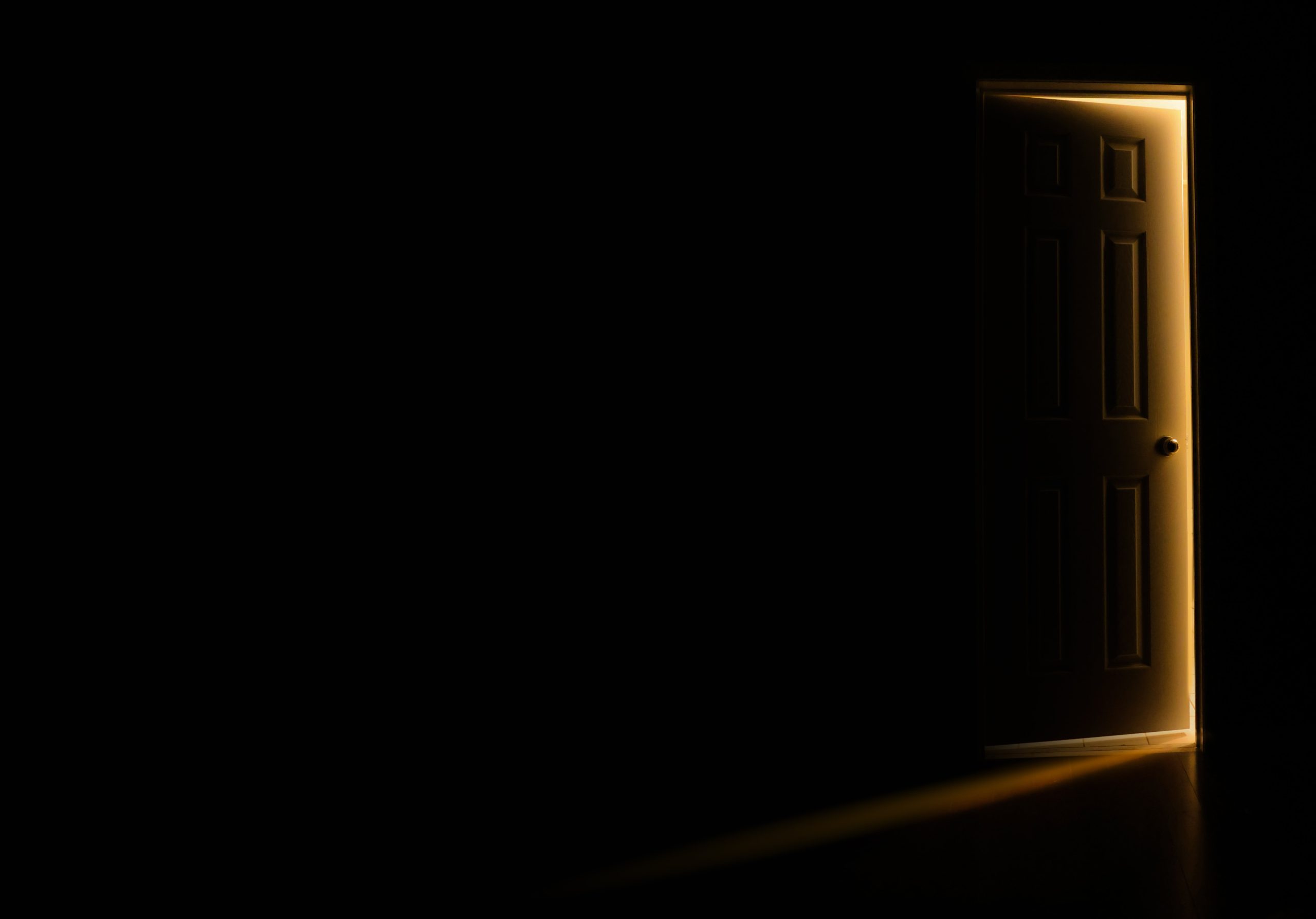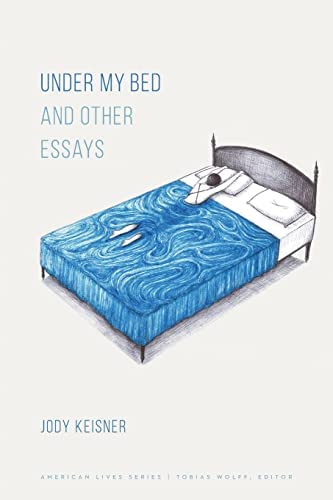In her debut collection, Under My Bed and Other Essays, Jody Keisner meticulously unpacks her fears, revealing their complex interiors. Her subject matter is diverse, ranging from 1980s horror films to parenting to adoption to wildfires to reincarnation to autoimmune disease to murder. She weaves research throughout her personal stories, which has the effect of ensuring that readers learn something about themselves and what it means to be human.
The collection is set primarily in Nebraska, but Keisner’s observations move beyond the general sense of the Midwest. She brings us murky man-made lakes as places of refuge and homes made of earth that look like bunkers. The location that most reverberates is that of the family unit. Keisner has many identities—daughter, granddaughter, wife, and mother—and each role requires something different from her; as a mother, she finds that she is best equipped to contend with the question of fear and what to do with it.
I spoke with Keisner over a series of emails about the genesis of her book, adoption conversations and what they are missing, and how she turns fear into action.
Sari Fordham: I loved this book and was so taken by your candor throughout. The collection is about fear, but it takes a lot of bravery to write so honestly about such a disdained topic. Was there a story that you had to talk yourself into writing?
Jody Keisner: I had to talk myself into writing the first chapter, which eventually became the title of the book. I was ashamed of my seemingly irrational fear of intruders and my compulsive nighttime “checking” of locks, behind furniture, under my bed, etc. Before I began writing about my fear and better understood where my bizarre behavior came from, I viewed both as a weakness, a childish preoccupation. I didn’t want to expose this particular weakness to the public, and I also feared that writing about it would become a self-fulfilling prophecy, as if my essay would manifest as an intruder. (I know. I know.) Of course writing about it helped me to see that my fear and other women’s fears of being alone at night aren’t all that irrational or childlike. While our reasons are as varied and complex as our experiences, they are also largely related to our awareness of the threat of violence from men.
A couple of months ago, I read this tweet asking how people made themselves feel safe at night if they lived alone. About a hundred people replied–mostly women–with answers ranging from knives under beds, chairs barring doors, dogs, guns, alarms, etc. I was surprised there were so many of us. For so long I had been ashamed of my “weakness.” Maybe my fear is more common than I realize.
SF: Oh, absolutely! I read the last chapter alone and in a sketchy Airbnb and I actually turned on a light before going to bed. While I knew driving to the Airbnb was statistically much more dangerous than staying in one alone, the idea of someone coming into the apartment felt much more tangible. You write: “Upward of 80 percent of American women will experience sexual harassment or assault during their lifetime.” How do you think this fact shapes female experiences?
JK: Statistically speaking, we women are unlikely to be murdered in our homes at night or while out for a solo jog, two examples I explore in my book. But also statistically speaking, we are likely to be sexually harassed and assaulted during our lifetimes. Too many of us will be raped or suffer domestic violence. Women–and especially BIPOC and trans folks–grow up under the ever-looming threat of violence from men. Frankly, our society doesn’t seem as perplexed by this fact as it should be. To put it bluntly: if white boys and men endured as much violence or the threat of violence as girls, women, BIPOC, and trans folk do, would our patriarchal society do as little as they are currently doing to stop it? Women grow up surrounded by images of real and imagined violence against the female body, which can certainly make us feel as if the threat is greater than it actually is. Not that some amount of threat isn’t all too real, especially the threat of sexual assault. I really hope this changes, but right now, I’m teaching my two daughters to be resilient and aware.
SF: Thank you! When a woman is afraid of violence, that fear is so often used to minimize women collectively. Meanwhile, male violence is viewed through the lens of the individual and we miss the opportunity to notice that something is broken in society. Throughout your book, you refuse to be minimized, which I found empowering. I came to see you as an expert on resilience in the face of fear. So I wanted to ask you, with so much terrifying stuff on the news, how can we respond without being overwhelmed?
JK: Wow. Thank you. I certainly don’t see myself as an expert on resilience! But I am a person of action, which is how my mother taught me to be. These days when I’m overwhelmed, which feels like a lot of the time, I know I must do something. Let’s say I’m overwhelmed at the gun violence we continue to endure as Americans, as but one example. I write a ranty Facebook message to connect with others or call them to action, too. I write to my representatives. I donate to support gun control reform. I write essays because I refuse meaninglessness. I practice self-care and go on long walks when my day allows it. I live in the now with my two daughters. But also: a good friend reminded me that none of us has to do all of these things at once. Just doing a little bit each day or each week helps. I can’t change our nation’s gun policies by myself or today, but I can do something small to help today. Humans have this amazing ability to thrive and go about their ordinary lives despite the horrible things that are happening all around us and all over the world. Yes, it’s resilience. We must be resilient in the face of adversity, trauma, and change. We just shouldn’t be complacent.
SF: I like that, particularly the value of small actions and how they can add up.
One of my favorite essays in this collection was the braided essay, “Fractured.” In it, you write about being adopted and your longing for reconnection. Later, you write about adopting your second daughter and the anger you feel at your friend who suggests your adopted daughter is somehow less yours. After Dobbs, adoption has come roaring to the edge of public consciousness. What are your thoughts about anti-choice politicians pointing to adoption as a solution for unwanted pregnancies?
JK: So, let me back up by saying it already troubles me that adoption is often viewed as a last resort for people who haven’t had luck with other reproductive avenues or medical interventions (if they can afford them). The common refrain goes, “Well, you can always adopt.” Adoption is a thing unto itself and it’s a very fraught, complicated thing. It certainly shouldn’t be viewed as a safety net for folks who have exhausted other options and are somewhat “resigned” to adopt. Adoption and the intricate, lengthy, and lifelong process of raising an adopted child has to be a priority and something you are committed to and fully invested in. An adopted child is an adoptee their entire life; the adoption component doesn’t disappear after the adoption is finalized in court. Families who are adopting should understand their adopted child will have different needs and likely have different struggles than a biological child would. This is even more complicated with interracial adoptions.
Those who propose adoption as an alternative to abortion are betraying their utter lack of knowledge about the psychological complexities of adoption and the reverberating and lifelong effects on the adoptee, the birth parents, and the adoptive parents. They are essentially saying to pregnant women: “Well, you can always surrender your baby after birth!” From what I understand, many women who place their children up for adoption do so because they don’t believe they have the financial means to raise a child, or an additional child. I’ve been fortunate enough to meet many birth mothers, including my own. They talk about the trauma of relinquishing their children and the lifelong grief and depression that sometimes follows. Adoption is traumatic for both the baby and mother. Framing adoption as the solution to abortion grossly under simplifies the reality of both.
Free and accessible birth control, comprehensive sex education in school, paid maternity and paternity leave—and for all employees and not just those in white collar jobs—affordable daycare, more services for children with disabilities, improved insurance plans to support family planning, access to emergency contraception, more financial support for programs that reduce domestic abuse, affordable housing. These are a few solutions to unwanted pregnancies. Medical intervention is also a solution to unwanted pregnancy and pregnancy that endangers the woman’s life. There is so much we should be doing to support women and children!
SF: Something I admired in this memoir is how you were able to place so many different stories in the same book, and how they all clicked together into a cohesive narrative. Could you talk a little bit about your writing process?
JK: I write about what is on my mind at the time, what I’m obsessing over. Which is to say, in terms of structure and unity, the book was all over the place when I had a first draft. I printed out each chapter and laid them out on the floor and looked for thematic connections. I probably re-ordered the book a dozen times, which also meant I had to revise as much, so that certain narrative threads carried throughout the book. For instance, the Pain-Thing appears in the second chapter, “Recreationally Terrified,” and also appears in a few of the other later chapters. That is the result of revision and my realization that I kept returning to my fear of pain and my fear of my loved ones being in pain. Connecting themes and metaphors helps create a sense of cohesion, and so does making sure important characters – like my Grandma Grace – make appearances in chapters even when they aren’t the central focus. I was also told by an early reader that I had a big hole in my narrative, and eventually filled that hole with “Haunted,” which more thoroughly explored my childhood relationship with my father.
SF: What advice do you have for someone who wants to write a memoir, but is having a difficult time finding a structure?
JK: I classify Under My Bed and Other Essays as a memoir-in-essays. I organized my book by theme: Origins (I seek out the origin stories of my greatest fears); Under the Skin (I examine the scientific reasons for humans’ experiences of love and fear); Risings (I explore the ways I overcome or learn to live with my fears). Within the themes, I mostly organized chapters chronologically, but not always. I move in and out of time a lot. I think “structure” is very personal to each book and the author’s writing style and preferences. There are so many possibilities!

